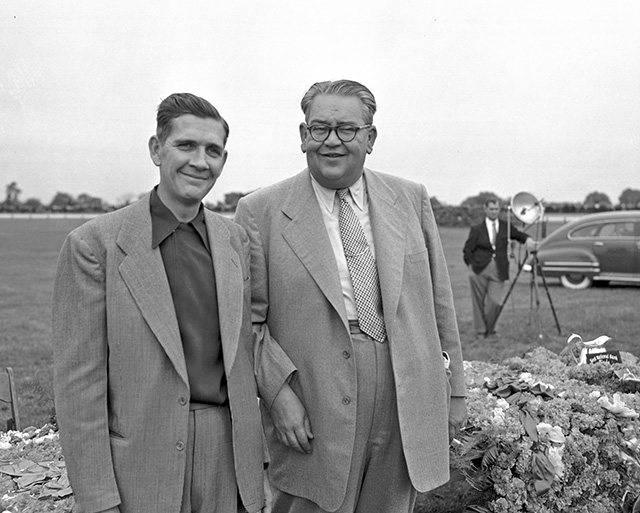
The Little Brown Jug, the premier pacing classic for 3-year-olds, provides a fascinating chapter in the more-than-a-century-old history of harness racing and the standardbred sport. The Jug, enriched by the tradition of the famed Grand Circuit and the picturesque backdrop of the Delaware Ohio County Fairgrounds, steadily maintains the flavor of the sport and competition from the days of its origin.
The founding of the Jug, which actually set its roots more than 65 years ago, is as unique as it is interesting. It began in 1937 when the Delaware County Agricultural Society’s members, at their annual meeting, voted to move the County Fair, held since its inception at Powell, to Delaware on a tract of land at the northern edge of the city. Two years later a half-mile track was built and provided the stage for harness racing. R.K. McNamara, a local contractor, designed and built the lightning fast track.
Enter attorney Joe Neville, whose family had been identified with the standardbred sport for many years, and his friend, Henry C. “Hank” Thomson, sports editor of The Delaware Gazette. Neville, who had campaigned horses on the Grand Circuit and was familiar with its officers and stewards, was successful in obtaining Grand Circuit dates for the new Delaware track. Neville, concerned over the years by the emphasis placed on the trotter, turned his efforts toward showcasing the pacers, particularly the 3-year-olds. The Little Brown Jug Society was formed to stage the Grand Circuit meeting. Neville headed the organization with Thomson as secretary-treasurer.
Then came the birth of the Little Brown Jug, named through a newspaper contest, with its previews in 1944 and 1945. The initial Jug in 1946, with a purse of $35,358, was won by Ensign Hanover with Delaware’s Wayne “Curly” Smart driving. Smart, a most successful trainer-driver on the Grand Circuit, was later to become an integral part of the Jug’s operation as the track superintendent. Over the years the track monopolized the half-mile record section with world standard performances, mainly through Smart’s skill in maintaining the fastest racing strip of its size in the country.
Through its humble beginnings, the Jug grew slowly to become perhaps the most traditional stake on the pacing gait. In 1956 the Jug provided the anchor for the newly designated Triple Crown of Pacing to go along with The Cane Pace at Yonkers (N.Y.) Raceway and the Messenger Stake then at Roosevelt Raceway in Westbury, N.Y. A review of Jug winners over the years produces the names of many of the all-time greats in the sport. The great Tar Heel, driven by Del Cameron, produced the first two-minute mile in 1951. Adios Butler, reined by Clint Hodgins, broke the two-minute barrier with a 1:59.2 clocking in 1959 and went on to become the first triple crown winner. Bret Hanover, with Frank Ervin in the sulky, added to Jug lore in 1965. After Smart-directed track maintenance crews scraped the racing surface following 24-hour rains, Bret Hanover won in the sensational time of 1:57. Bret’s time remained the fastest until 1977 when Governor Skipper, driven by John Chapman, won in 1:56.1. Hot Hitter was the 1979 victor in 1:55.3, Niatross in 1980 in 1:54.4, and Lonestar Legend became the first 1:50 performer in 2008 with his 1:49.3 mile.
This pacing stake has maintained its impeccable reputation through the efforts of the Little Brown Jug Society with the cooperation of its host, the Delaware County Agricultural Society. The Little Brown Jug is a part of Americana. And it shall ever remain so.
© 2021 Delaware County Agricultural Society | All Rights Reserved~